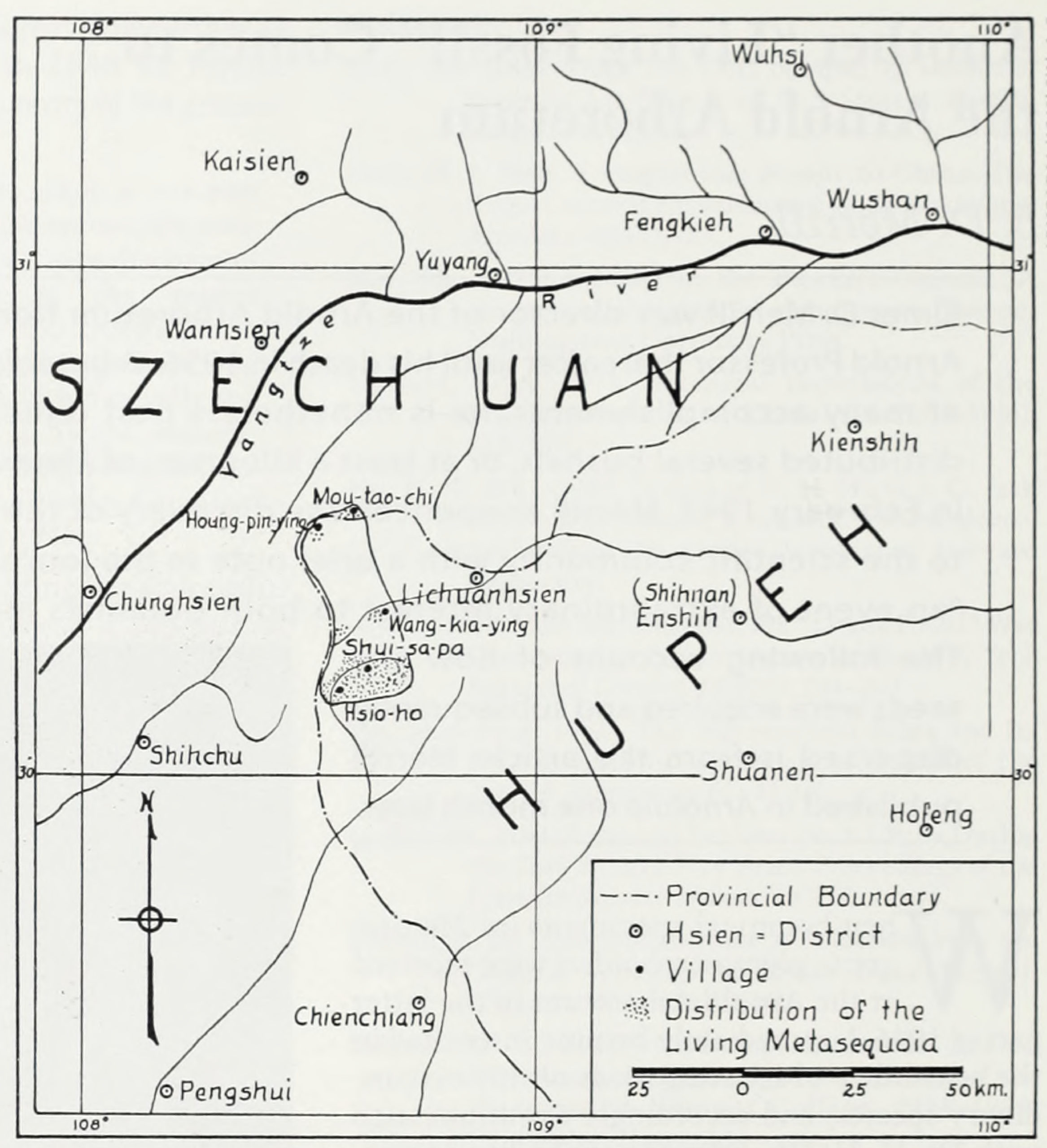Elmer D. Merrill was director of the Arnold Arboretum from 1935 to 1946 and Arnold Professor thereafter until his death in 1956. A botanist and administrator of many accomplishments, he is nonetheless best remembered for having distributed several bushels, or at least a kilogram, of Metasequoia seeds. Early in February 1948, Merrill announced the discovery of the living Metasequoia to the scientific community with a brief note in the journal Science, calling it “an event of extraordinary interest to both botanists and paleobotanists.” The following account of how the seeds were acquired and subsequently dispersed is from the article Merrill published in Arnoldia one month later.
When botanical specimens [of Metasequoia glyptostroboides] were received at the Arnold Arboretum in the latter part of 1946, I immediately became interested in the possibility of securing seeds of this extraordinary species, and accordingly communicated with Dr. H. H. Hu, Director of the Fan Memorial Institute of Biology in Peiping, one of the joint authors concerned with the actual description of the species. Incidentally, Dr. H. H. Hu was trained at the Arnold Arboretum, receiving his Sc.D. degree from Harvard University in 1925. Dr. Hu responded favorably and accordingly a modest grant was made from the Arnold Arboretum’s restricted Chinese exploration fund provided by the late Harrison W. Smith of Tahiti, himself a graduate of Harvard in 1895 and long interested in matters Chinese. On the basis of this grant Professor Cheng organized a third expedition to the type locality, this also led by his assistant Mr. Hsueh.*
… While 1947 was reported as not being a good seed year, an ample supply of seeds was secured during the time that Mr. Hsueh was in the field. These were delivered in Nanking early in December; the first small sending reached Boston January 5, 1948, and a second and larger shipment is now in transit. Seeds were planted in our propagating house early in January, and many of these germinated before the end of the month. Thus it is that in due time the Arnold Arboretum will have a certain number of living plants for distribution.



Following long established Arnold Arboretum practice, packets of seeds have been widely distributed to institutions in the United States and Europe. It is, of course, not known whether this remarkable species will prove to be hardy under the rather difficult climatic conditions characteristic of the Boston area. With excellent germination records it is now certain that we shall be able to establish this ancient but now nearly extinct type in various parts of the United States and elsewhere, for somewhere, with us, favorable climatic conditions will be found—if not in the Northeast, then in the South or on the West Coast.
The point is emphasized that in spite of the present unfavorable economic conditions, in spite of adversities in China rendering travel difficult, and in spite of unfavorable exchange conditions, this cooperative project did succeed; that as a result an ample supply of seeds is available ; that the seeds are viable; and, this being the case, the Arnold Arboretum has made an important contribution, working through its Chinese associates, in thus being involved in an attempt to preserve a remarkable conifer, and a species that in its native habitat is apparently not far from the verge of extinction. Incidentally, Professor Cheng who, with Dr. Hu, cooperated with us, writes that without the modest grant made by the Arnold Arboretum, it would have been impossible for his representative to make the trip to Szechuan and Hupeh in 1947, and comments on the fact that trees are being rapidly destroyed by cutting in this region as well as in various other parts of China….
It has been argued in some quarters that we approach the condition of diminishing returns in the botanical exploration of China, a field that has long been one in which the Arnold Arboretum has specialized. This statement is doubtless true to a certain degree, but from what has appeared in extensive collections made within the past three decades, I am of the opinion that a vast amount of fieldwork is still called for and is still justified. This remarkable Metasequoia find bears out this belief. In spite of all that has been published on the enormously rich flora of China in the past century, and particularly within the past four or five decades, there are vast areas still remaining to be explored, and the already known flora will be very greatly increased, as to the number of actually known species, when the more recently assembled collections are studied in detail.
Citation: Merrill, E. D. 1998. Another “living fossil” comes to the Arnold Arboretum. Arnoldia, 58(4): 17–19.
Exerpted from “Metasequoia, Another ’Living Fossil,”’ Arnoldia (5 March 1948/ 8/1/: 1-8.
* The third expedition was led by C. T. Hwa.
For an account of Merrill’s early years and of his time in the Philippines, see “E. D. Merrill, From Maine to Manila” by Ida Hay in Arnoldia (Spring 1998) 58(1): 11-19.
From “free” to “friend”…
Established in 1911 as the Bulletin of Popular Information, Arnoldia has long been a definitive forum for conversations about temperate woody plants and their landscapes. In 2022, we rolled out a new vision for the magazine as a vigorous forum for tales of plant exploration, behind-the-scenes glimpses of botanical research, and deep dives into the history of gardens, landscapes, and science. The new Arnoldia includes poetry, visual art, and literary essays, following the human imagination wherever it entangles with trees.
It takes resources to gather and nurture these new voices, and we depend on the support of our member-subscribers to make it possible. But membership means more: by becoming a member of the Arnold Arboretum, you help to keep our collection vibrant and our research and educational mission active. Through the pages of Arnoldia, you can take part in the life of this free-to-all landscape whether you live next door or an ocean away.
